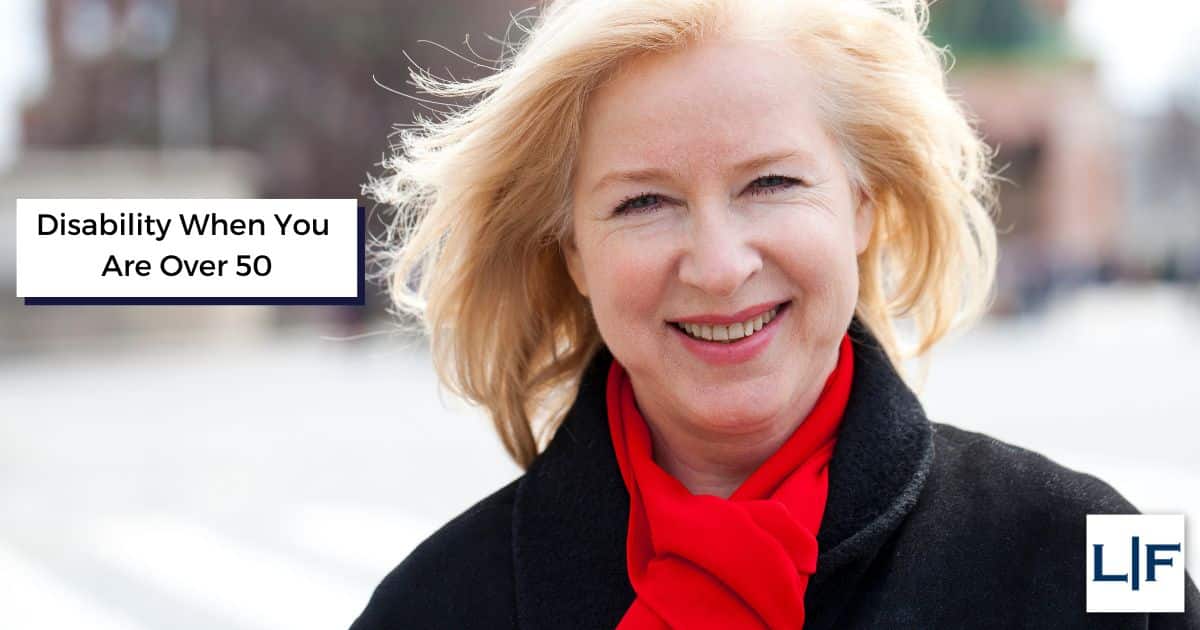Disabled persons that do not meet the criteria under a listing in the Social Security Administration’s (SSA) Blue Book might still be eligible for benefits if the SSA awards them with a medical vocational allowance. Being of advanced age can work in your favor when the SSA reviews your case.
Lunn and Forro, PLLC has helped hundreds of disabled people of all ages win their Social Security disability benefits. Call our office today at 888-966-6566 and learn how we can help you get Social Security disability benefits when you’re over 50.
How do the grids (medical vocational) allowances work?
When a disability applicant has a condition that does not meet a listing, the SSA reviews the claimant’s medical files and performs an RFC (residual functional capacity) assessment to rate the claimant’s functional abilities. The claims examiner will use physical and/or mental RFC forms to analyze what types of limitations the claimant has and decide if he is capable of doing his prior job or adjusting to new work despite the limitations.
After reviewing all of the claimant’s information, the examiner will categorize the claimant into one of four functional capacities:
- Sedentary work
- Light work
- Medium work
- Heavy work
When the SSA makes a determination about disability, a worker who is able to adjust to other work does not meet the definition of disabled. However, age might affect that determination. For example, the SSA will likely not deem workers who are able to engage in heavy work as disabled. However, older workers limited to sedentary, light, or medium work whose age limits their ability to adjust to new work may still be able to win benefits via a medical vocational allowance.
To determine eligibility for disability in claims when the person is over 50 the SSA sometimes uses “medical-vocational grids.” (More on the grids later.)
If the SSA decides that he is still capable of working or adjusting to a new job, it will deny benefits. If the SSA thinks the claimant’s condition and situation truly makes working out of the question, then it will grant a medical vocational allowance.
How is being 50 or older an advantage when it comes to disability benefits?
When you are age 50 or older, you have somewhat of an advantage over younger people when it comes to winning Social Security disability benefits on a medical vocational allowance. Why? Because the SSA recognizes that it is often more challenging for older workers to acclimate to new work.
Being of an advanced age can mean limited career opportunities because of health and mental conditions, outdated job skills, and the fact that employers are often less likely to hire older workers. As such, the SSA sometimes gives older applicants a break when it comes to determining eligibility for disability benefits.
The SSA has two special categories for older people:
- “Closely Approaching Advanced Age”: age 50 to 54
- “Advanced Age”: age 55 and older
When an examiner performs the RFC assessment, s/he will refer to medical-vocational grids, provided in the Code of Federal Regulations. The grids are more lenient for claimants of advanced age and those approaching advanced age, making it easier to win benefits.
For instance, according to the grids, the SSA will not deem a claimant aged 45 with limited skills and education limited to sedentary work disabled (the SSA would assume he has the time to learn new skills and adjust to different sedentary work); whereas, the SSA would deem a claimant aged 50 disabled.
Medical-Vocational Grids for Those Aged 50 and Older
If you are age 50 or older, here the examples of the grids the SSA will refer to when reviewing your case, categorized by functional capacity:
Grid 1: Limited to Sedentary Work
| Education | Work Experience | Determination |
| Limited or less | Unskilled or none | Age 55+: Disabled Age 50-54: Disabled |
| Limited or Less | Skilled or semiskilled—skills not transferable | Age 55+: Disabled Age 50-54: Disabled |
| Limited or Less | Skilled or semiskilled—skills transferable | Age 55+: Not Disabled Age 50-54: Not Disabled |
| High school graduate but not capable of direct entry into skilled work | Unskilled or none | Age 55+: Disabled Age 50-54: Disabled |
| High school graduate and capable of direct entry into skilled work | Unskilled or none | Age 55+: Not Disabled Age 50-54: Not Disabled |
Grid 2: Limited to Light Work
| Education | Work Experience | Determination |
| Limited or less | Unskilled or none | Age 55+: Disabled Age 50-54: Not Disabled |
| Limited or Less | Skilled or semiskilled—skills not transferable | Age 55+: Disabled Age 50-54: Not Disabled |
| Limited or Less | Skilled or semiskilled—skills transferable | Age 55+: Not Disabled Age 50-54: Not Disabled |
| High school graduate but not capable of direct entry into skilled work | Unskilled or none | Age 55+: Disabled Age 50-54: Not Disabled |
| High school graduate and capable of direct entry into skilled work | Unskilled or none | Age 55+: Not Disabled Age 50-54: Not Disabled |
Grid 3: Limited to Medium Work
| Education | Work Experience | Determination |
| Limited or less | None | Age 55+: Disabled Age 50-54: Not Disabled |
| Limited or less | Unskilled | Age 55+: Not Disabled Age 50-54: Not Disabled |
| Limited or Less | Skilled or semiskilled—skills not transferable | Age 55+: Not Disabled Age 50-54: Not Disabled |
| Limited or Less | Skilled or semiskilled—skills transferable | Age 55+: Not Disabled Age 50-54: Not Disabled |
| High school graduate but not capable of direct entry into skilled work | Unskilled or none | Age 55+: Not Disabled Age 50-54: Not Disabled |
| High school graduate and capable of direct entry into skilled work | Unskilled or none | Age 55+: Not Disabled Age 50-54: Not Disabled |
How can I improve my chances of winning my disability benefits?
It is not easy to win disability benefits, but being age 50 or older is definitely a mark in your favor. If you are between 62 and 67 and collecting early retirement you may sill qualify for benefits, so consult with a disability attorney to see about eligibility. You can improve your chances of collecting benefits by discussing your case with a qualified disability attorney from Lunn and Forro, PLLC.
Our team can assist you with your claim and help you pursue the benefits you need. We can review your case, see if you will likely qualify for benefits, and then walk you through the application process, assisting with any tasks along the way.
Contact us today for a free, no-obligation consultation: 888-966-6566.
Related Posts

When am I Considered Disabled by Social Security?
Social Security considers you to be disabled when you have a serious medical condition that prevents you from working. To determine whether a person is

What Is SSI?
Supplemental Security Income (SSI) is a safety net for certain individuals with low income and little assets. SSI provides money so these people can meet

What Is SSDI – Social Security Disability Insurance?
SSDI, which is also called Social Security Disability Insurance, is a government program that gives disabled American workers a monthly income. When you suffer from

Can You Receive Inheritance While on Social Security Disability?
Yes. Inheritance can affect Social Security disability benefits. Much depends on the type of benefit you receive. Below, we discuss the implications of inheritances in
Can I Qualify for Both SSI and SSDI Disability Benefits?
Yes. In some cases, you may be able to qualify for both Supplemental Security Income (SSI) and Social Security Disability Insurance (SSDI) benefits. The Social
What are the Disability Listings for a Social Security Claim?
The disability listings can make it easier for you to qualify for Social Security disability benefits. If you are considering filing an application for Social
How Do I File a Disability Appeal?
You gave Social Security Disability all the information they asked for and agreed to a medical exam, but your disability claim was still denied. It
What If I Miss My Social Security Appeal Deadline?
What is the Social Security Disability Appeal Deadline? The most common Social Security Disability appeal deadline is 60 days. If your initial claim is denied,



